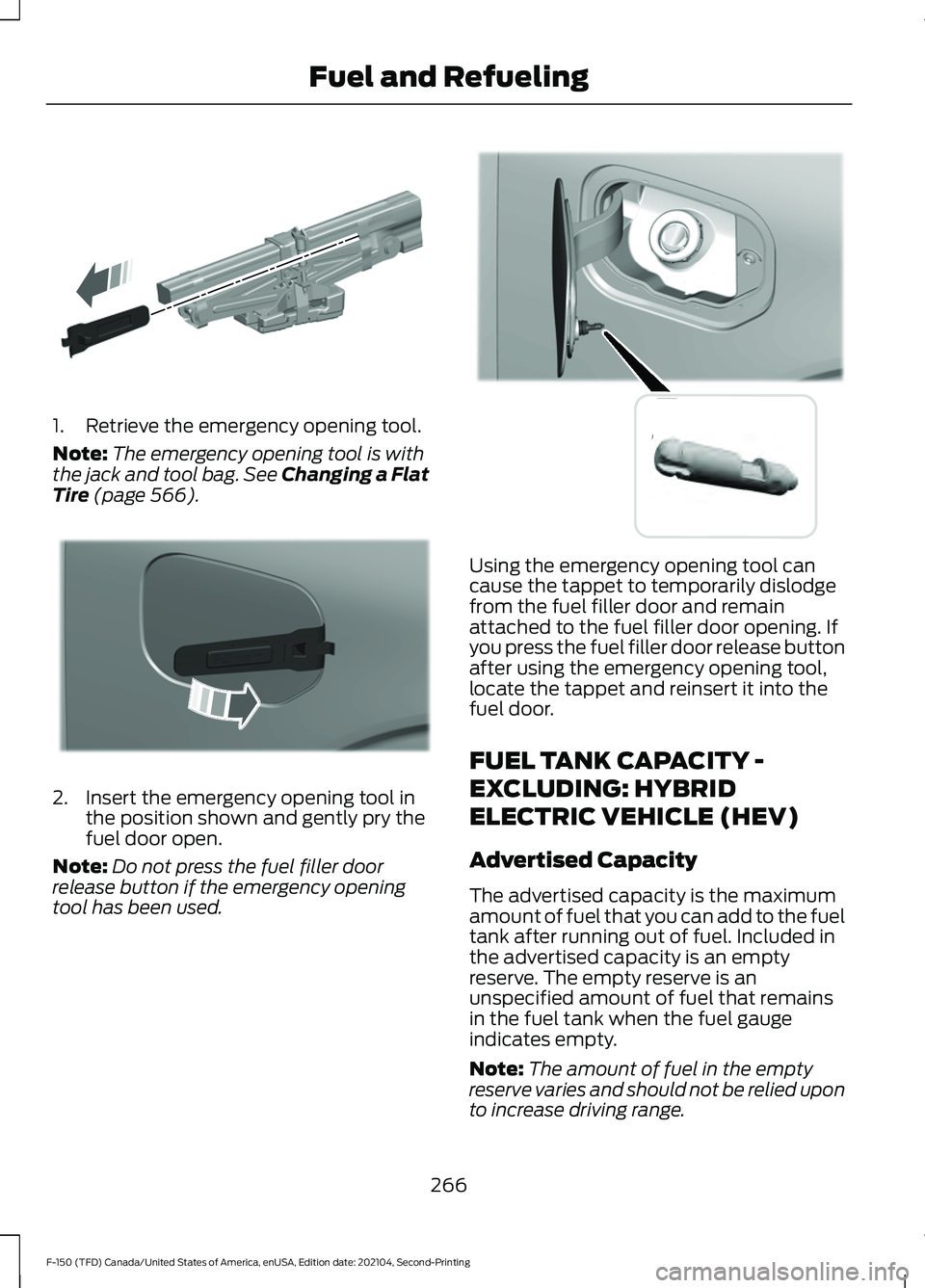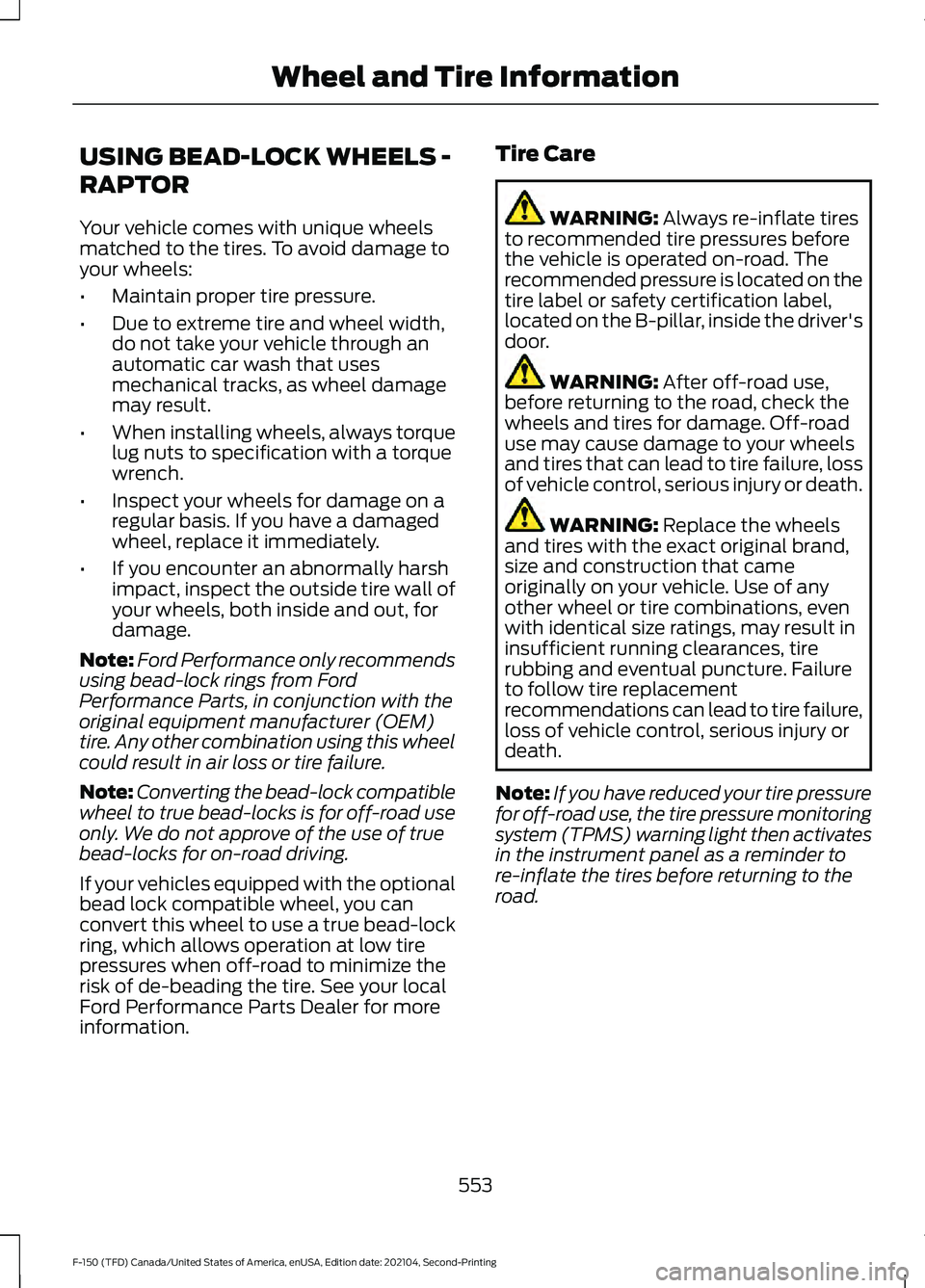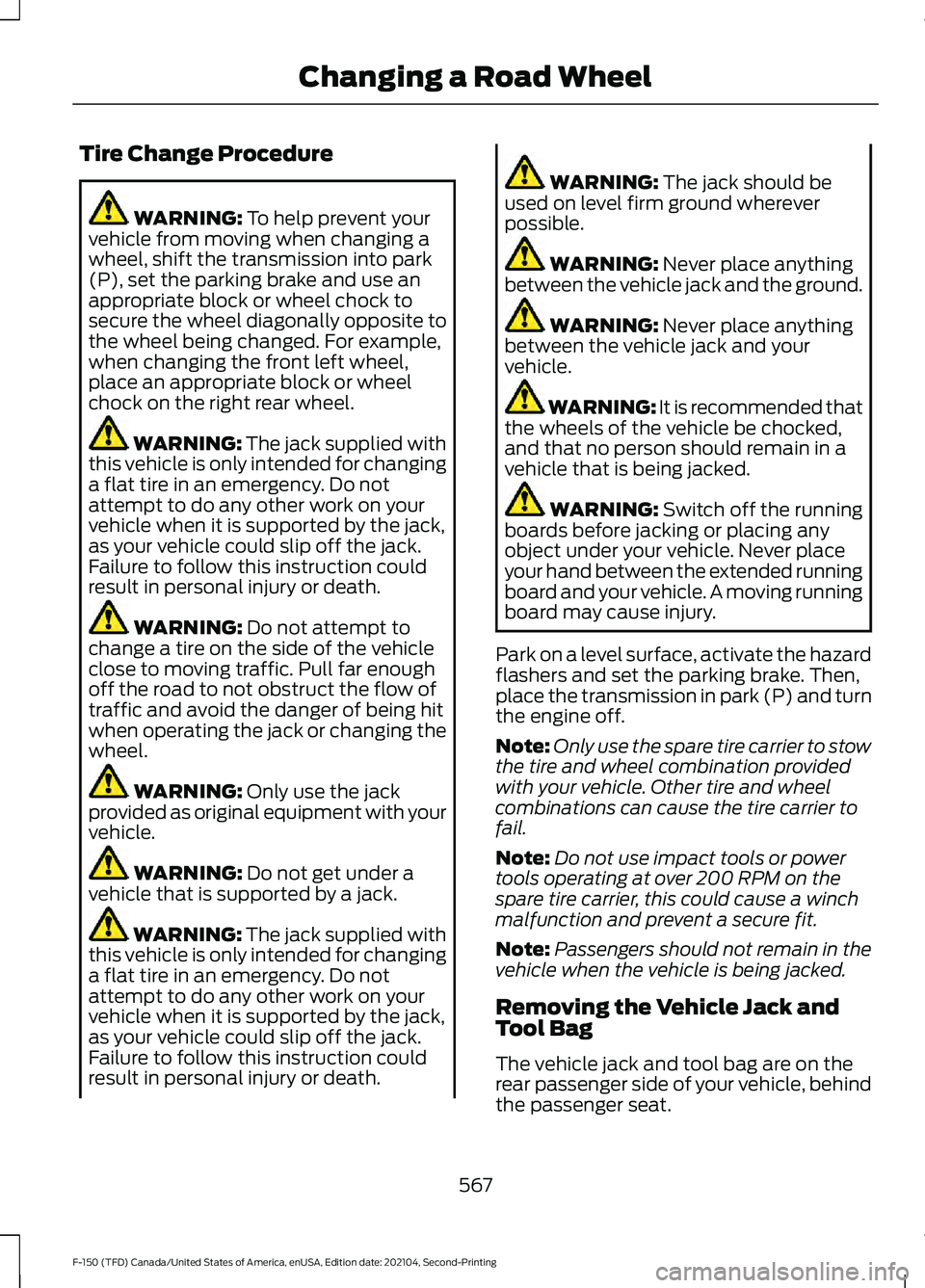2021 FORD F-150 run flat
[x] Cancel search: run flatPage 270 of 796

1. Retrieve the emergency opening tool.
Note:
The emergency opening tool is with
the jack and tool bag. See Changing a Flat
Tire (page 566). 2. Insert the emergency opening tool in
the position shown and gently pry the
fuel door open.
Note: Do not press the fuel filler door
release button if the emergency opening
tool has been used. Using the emergency opening tool can
cause the tappet to temporarily dislodge
from the fuel filler door and remain
attached to the fuel filler door opening. If
you press the fuel filler door release button
after using the emergency opening tool,
locate the tappet and reinsert it into the
fuel door.
FUEL TANK CAPACITY -
EXCLUDING: HYBRID
ELECTRIC VEHICLE (HEV)
Advertised Capacity
The advertised capacity is the maximum
amount of fuel that you can add to the fuel
tank after running out of fuel. Included in
the advertised capacity is an empty
reserve. The empty reserve is an
unspecified amount of fuel that remains
in the fuel tank when the fuel gauge
indicates empty.
Note:
The amount of fuel in the empty
reserve varies and should not be relied upon
to increase driving range.
266
F-150 (TFD) Canada/United States of America, enUSA, Edition date: 202104, Second-Printing Fuel and RefuelingE333731 E333736 E333737
Page 481 of 796

•
Moderate braking is particularly
important since it allows you to
maximize the energy captured by the
regenerative braking system.
• Drive at steady speeds without
stopping.
• Anticipate stops; slowing down may
eliminate the need to stop.
• Driving on flat terrain.
• Drive at reasonable speeds and
observe posted speed limits.
• Shut all windows when driving at high
speeds.
• Combine errands and minimize
stop-and-go driving.
• Drive with the tonneau cover installed
if your vehicle comes with one.
• Keep the tires properly inflated and use
only the recommended size.
• Use the recommended engine oil.
• Follow the recommended maintenance
schedule and carry out the
recommended checks.
• Perform all scheduled maintenance.
Note: Having your engine running is not
always an indication of inefficiency. In some
cases, it is actually more efficient than
driving in electric mode.
Avoid these actions; they reduce your fuel
consumption:
• Revving the engine.
• Aggressive driving increases the
amount of energy required to move
your vehicle.
• Driving in lower temperatures during
the first 5–10 mi (12 –16 km) of driving.
• Idle for periods longer than one minute.
• Use the air conditioner or front
defroster. •
Adding certain accessories to your
vehicle like bug deflectors, rollbars,
light bars, running boards, ski racks or
luggage racks.
• Use the speed control in hilly terrain.
• Using fuel blended with alcohol.
• Drive a heavily loaded vehicle or tow a
trailer.
• Driving with the wheels out of
alignment.
DRIVING IN SPECIAL
CONDITIONS
EMERGENCY MANEUVERS
In an unavoidable emergency where you
must make a sudden sharp maneuver, turn
the steering wheel only as rapidly and as
far as required to avoid the emergency.
Apply smooth pressure to the accelerator
pedal or brake pedal as needed. Avoid
abrupt steering, acceleration and braking
changes. Abrupt changes could increase
the risk of vehicle roll over, loss of vehicle
control and personal injury. If possible, use
any available road surfaces to bring your
vehicle under control.
FLOOR MATS WARNING:
Use a floor mat
designed to fit the footwell of your
vehicle that does not obstruct the pedal
area. Failure to follow this instruction
could result in the loss of control of your
vehicle, personal injury or death. WARNING:
Pedals that cannot
move freely can cause loss of vehicle
control and increase the risk of serious
personal injury.
477
F-150 (TFD) Canada/United States of America, enUSA, Edition date: 202104, Second-Printing Driving Hints
Page 557 of 796

USING BEAD-LOCK WHEELS -
RAPTOR
Your vehicle comes with unique wheels
matched to the tires. To avoid damage to
your wheels:
•
Maintain proper tire pressure.
• Due to extreme tire and wheel width,
do not take your vehicle through an
automatic car wash that uses
mechanical tracks, as wheel damage
may result.
• When installing wheels, always torque
lug nuts to specification with a torque
wrench.
• Inspect your wheels for damage on a
regular basis. If you have a damaged
wheel, replace it immediately.
• If you encounter an abnormally harsh
impact, inspect the outside tire wall of
your wheels, both inside and out, for
damage.
Note: Ford Performance only recommends
using bead-lock rings from Ford
Performance Parts, in conjunction with the
original equipment manufacturer (OEM)
tire. Any other combination using this wheel
could result in air loss or tire failure.
Note: Converting the bead-lock compatible
wheel to true bead-locks is for off-road use
only. We do not approve of the use of true
bead-locks for on-road driving.
If your vehicles equipped with the optional
bead lock compatible wheel, you can
convert this wheel to use a true bead-lock
ring, which allows operation at low tire
pressures when off-road to minimize the
risk of de-beading the tire. See your local
Ford Performance Parts Dealer for more
information. Tire Care WARNING: Always re-inflate tires
to recommended tire pressures before
the vehicle is operated on-road. The
recommended pressure is located on the
tire label or safety certification label,
located on the B-pillar, inside the driver's
door. WARNING:
After off-road use,
before returning to the road, check the
wheels and tires for damage. Off-road
use may cause damage to your wheels
and tires that can lead to tire failure, loss
of vehicle control, serious injury or death. WARNING:
Replace the wheels
and tires with the exact original brand,
size and construction that came
originally on your vehicle. Use of any
other wheel or tire combinations, even
with identical size ratings, may result in
insufficient running clearances, tire
rubbing and eventual puncture. Failure
to follow tire replacement
recommendations can lead to tire failure,
loss of vehicle control, serious injury or
death.
Note: If you have reduced your tire pressure
for off-road use, the tire pressure monitoring
system (TPMS) warning light then activates
in the instrument panel as a reminder to
re-inflate the tires before returning to the
road.
553
F-150 (TFD) Canada/United States of America, enUSA, Edition date: 202104, Second-Printing Wheel and Tire Information
Page 571 of 796

Tire Change Procedure
WARNING: To help prevent your
vehicle from moving when changing a
wheel, shift the transmission into park
(P), set the parking brake and use an
appropriate block or wheel chock to
secure the wheel diagonally opposite to
the wheel being changed. For example,
when changing the front left wheel,
place an appropriate block or wheel
chock on the right rear wheel. WARNING:
The jack supplied with
this vehicle is only intended for changing
a flat tire in an emergency. Do not
attempt to do any other work on your
vehicle when it is supported by the jack,
as your vehicle could slip off the jack.
Failure to follow this instruction could
result in personal injury or death. WARNING:
Do not attempt to
change a tire on the side of the vehicle
close to moving traffic. Pull far enough
off the road to not obstruct the flow of
traffic and avoid the danger of being hit
when operating the jack or changing the
wheel. WARNING:
Only use the jack
provided as original equipment with your
vehicle. WARNING:
Do not get under a
vehicle that is supported by a jack. WARNING:
The jack supplied with
this vehicle is only intended for changing
a flat tire in an emergency. Do not
attempt to do any other work on your
vehicle when it is supported by the jack,
as your vehicle could slip off the jack.
Failure to follow this instruction could
result in personal injury or death. WARNING:
The jack should be
used on level firm ground wherever
possible. WARNING:
Never place anything
between the vehicle jack and the ground. WARNING:
Never place anything
between the vehicle jack and your
vehicle. WARNING: It is recommended that
the wheels of the vehicle be chocked,
and that no person should remain in a
vehicle that is being jacked. WARNING:
Switch off the running
boards before jacking or placing any
object under your vehicle. Never place
your hand between the extended running
board and your vehicle. A moving running
board may cause injury.
Park on a level surface, activate the hazard
flashers and set the parking brake. Then,
place the transmission in park (P) and turn
the engine off.
Note: Only use the spare tire carrier to stow
the tire and wheel combination provided
with your vehicle. Other tire and wheel
combinations can cause the tire carrier to
fail.
Note: Do not use impact tools or power
tools operating at over 200 RPM on the
spare tire carrier, this could cause a winch
malfunction and prevent a secure fit.
Note: Passengers should not remain in the
vehicle when the vehicle is being jacked.
Removing the Vehicle Jack and
Tool Bag
The vehicle jack and tool bag are on the
rear passenger side of your vehicle, behind
the passenger seat.
567
F-150 (TFD) Canada/United States of America, enUSA, Edition date: 202104, Second-Printing Changing a Road Wheel
Page 779 of 796

Extending the Exterior Mirrors.................166
Extending the Remote Start
Duration........................................................184
Exterior Bulbs................................................522
Changing a Front Fog Lamp Bulb...............528
Changing a Front Side Marker Lamp
Bulb.................................................................... 527
Changing a Front Turn Signal Lamp Bulb.................................................................... 526
Changing a Headlamp Bulb.......................... 524
Changing a High Mounted Stoplamp Bulb................................................................... 530
Changing a License Plate Lamp Bulb................................................................... 530
Changing a Rear Lamp Bulb......................... 528
Changing a Rear Turn Signal Lamp Bulb.................................................................... 529
Changing a Reversing Lamp Bulb...............530
Changing a Stoplamp Bulb........................... 529
Exterior Bulb Specification Chart................522
Removing a Rear Lamp Assembly..............524
Exterior Lamps
..............................................149
Exterior Lamp Audible Warning.....................151
Exterior Lamp Indicators................................... 151
How Do Cornering Lamps Work................... 149
Switching the Cargo Lamps On.................... 150
Switching the Daytime Running Lamps On and Off.............................................................. 149
Switching the Front Fog Lamps On and Off....................................................................... 150
Switching the Spot Lamps On and Off....................................................................... 150
Switching the Turn Signal Lamps On and Off....................................................................... 149
Exterior Lighting Control.............................147
Exterior Lighting Control - Police Responder....................................................147
Exterior Lighting
.............................................147
Adaptive Front Lighting.................................... 157
Autolamps............................................................ 148
Automatic High Beam Control...................... 152
Automatic High Beam Control – Troubleshooting............................................. 154
Exterior Lamps.................................................... 149
Exterior Zone Lighting........................................ 151
Glare Free Lighting............................................. 155
Glare Free Lighting – Troubleshooting.............................................. 157Headlamps............................................................
147
Headlamps – Troubleshooting.....................148
Exterior Mirrors
..............................................165
Auto-Dimming Exterior Mirror....................... 166
Exterior Zone Lighting
..................................151
Exterior Zone Lighting Settings..................... 152
Using the Exterior Zone Lighting.................... 151
What Is Exterior Zone Lighting........................ 151
F
Fastening and Unfastening the Seatbelts
........................................................64
Feature Bar....................................................638
Filling the Selective Catalytic Reduction System Tank................................................275
Filling the Selective Catalytic Reduction System Tank in Cold Weather..................275
Filling the Selective Catalytic Reduction System Tank Using a Fuel Station
Pump.................................................................. 275
Filling the Selective Catalytic Reduction System Tank Using a Portable
Container.......................................................... 276
Flat Tire See: Changing a Flat Tire............................... 566
Floor Mats.......................................................477
Folding the Exterior Mirrors - Vehicles With: Manual Folding Mirrors................165
Folding the Exterior Mirrors - Vehicles With: Power Folding Mirrors..................165
Foot Pedals See: Adjusting the Pedals................................ 142
Ford Performance...........................................21
Ford Protect
..................................................662
Four-Wheel Drive.........................................291
Four-Wheel Drive Modes................................ 295
Four-Wheel Drive – Troubleshooting.........297
Four-Wheel Drive Indicators...................296
Four-Wheel Drive Limitations.................292
Four-Wheel Drive Modes
..........................295
Four-Wheel Drive Auto.................................... 295
Four-Wheel Drive High.................................... 296
Four-Wheel Drive Low..................................... 296
Two-Wheel Drive High..................................... 295
Four-Wheel Drive Precautions...............292
775
F-150 (TFD) Canada/United States of America, enUSA, Edition date: 202104, Second-Printing Index
Page 787 of 796

Power Running Board Kick Switch........138
Power Running Board Precautions........138
Power Running Board Settings...............138
Power Running Boards...............................138
Power Running Boards –
Troubleshooting............................................. 139
Power Running Boards – Troubleshooting.........................................139
Power Running Boards – Frequently Asked Questions......................................................... 139
Power Seats
...................................................198
Adjusting the Head Restraint........................ 198
Adjusting the Lumbar Support..................... 201
Adjusting the Seat Backrest......................... 200
Adjusting the Seat Cushion........................... 200
Adjusting the Seat Height............................... 201
Head Restraint Components......................... 198
Installing the Head Restraint......................... 199
Moving the Seat Backward and Forward............................................................. 199
Removing the Head Restraint....................... 199
Pre-Collision Assist Limitations - Police Responder...................................................397
Pre-Collision Assist Limitations.............397
Pre-Collision Assist Precautions...........396
Pre-Collision Assist
....................................396
Automatic Emergency Braking..................... 401
Distance Alert...................................................... 401
Distance Indication.......................................... 400
Evasive Steering Assist................................... 402
Pre-Collision Assist – Troubleshooting............................................ 403
Pre-Collision Assist – Troubleshooting
.......................................403
Pre-Collision Assist – Frequently Asked
Questions........................................................ 405
Pre-Collision Assist – Information Messages......................................................... 403
Pre-Collision Assist – Warning Lamps............................................................... 403
Preparing Your Vehicle for Storage.........................................................540
Programming a MyKey
...............................100
Programming the Garage Door Opener to Your Garage Door Opener
Motor...............................................................211
Programming the Garage Door Opener to Your Gate Opener Motor....................212 Programming the Garage Door Opener
to Your Hand-Held Transmitter.............211
Programming the Remote Control - Vehicles With: Flip Key..............................96
Programming the Remote Control - Vehicles With: Push Button Start.........95
Properly Adjusting the Driver and Front Passenger Seats..........................................75
Puncture See: Changing a Flat Tire............................... 566
Push Button Ignition Switch....................237
R
Radio Frequency Certification Labels............................................................705
Blind Spot Information System Sensors............................................................. 705
Body Control Module....................................... 706
Cruise Control Module..................................... 709
Garage Door Opener........................................... 711
Keys and Remote Controls.............................. 712
Passive Anti-Theft System.............................. 715
Radio Transceiver Module............................... 719
SYNC........................................................................\
721
Tire Pressure Monitoring System Sensors............................................................. 726
Wireless Accessory Charging Module.............................................................. 730
Rear Axle Fluid Capacity and Specification - Police Responder
........618
Rear Axle Fluid Capacity and Specification - Raptor..............................617
Rear Axle Fluid Capacity and Specification...............................................616
Rear Exterior - Police Responder.............48
Rear Exterior - Raptor...................................47
Rear Exterior....................................................46
Rear Occupant Alert System Audible Warnings
.....................................................208
Rear Occupant Alert System Indicators.....................................................208
Rear Occupant Alert System Limitations...................................................207
Rear Occupant Alert System Precautions.................................................207
Rear Occupant Alert System
...................207
783
F-150 (TFD) Canada/United States of America, enUSA, Edition date: 202104, Second-Printing Index